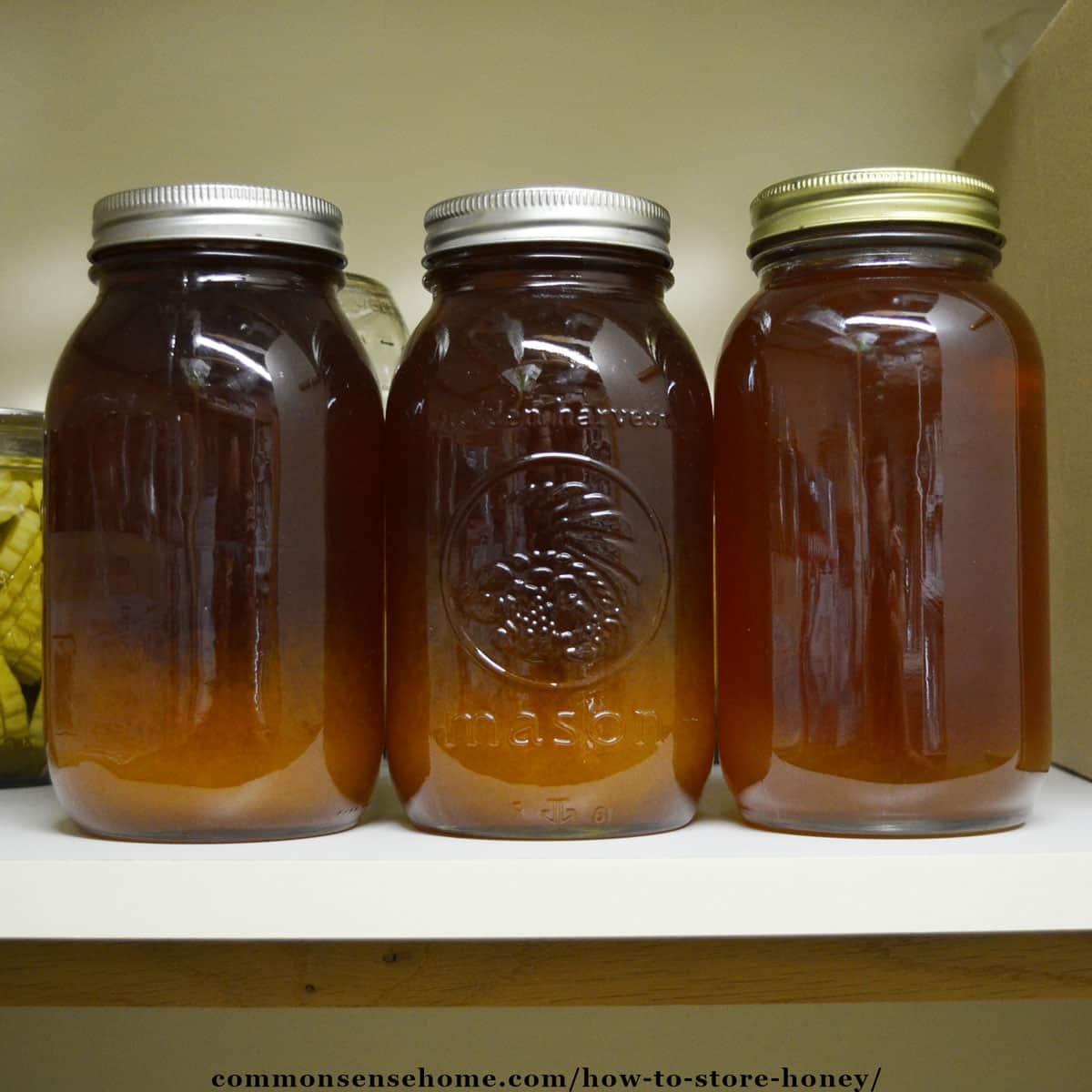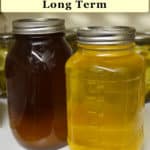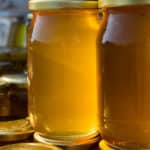How to Store Honey Long Term
Honey is an amazing substance that is both food and medicine. If you store raw honey correctly, it lasts forever, or at least close to it. (Edible honey thousands of years old was found in Egyptian tombs.) We share tips for honey storage, and answers to common questions about honey.

7 Reasons Why You Should Store Honey
- Honey lasts forever.
- It is an all natural sweetener with a lower glycemic index than cane or beet sugar.
- Honey is medicinal.
- You can save money buying honey in bulk, especially on sale.
- No refrigeration required.
- Tastes awesome as honey mead, which may also be medicinal.
- Great for bartering in a SHTF situation.
How to Store Honey
Honey is hygroscopic, which means that it absorbs moisture. To store honey long term, you need to keep it in a tightly sealed container. Choose glass or heavy duty food grade plastic. Ideally, keep it in the dark, away from heat.
Honey sold in sturdy food grade buckets is safe for long term storage. Raw honey is acidic, with a pH between 3 and 4.5, so you should never store honey in metal containers.
Date and label your storage containers to help you rotate your storage. We get bulk honey in thin plastic two quart containers from a local apiary that we repack into 1 quart glass jars for storage.
The best temps for honey storage are between 57 to 80℉ (13 to 27℃ ), but it's okay to store it hotter or colder. High temperatures may degrade the quality slightly, but properly sealed honey will not spoil.
How much Honey Should I Store?
A general rule of thumb is to store 60+ pounds of sugar per year per adult. The 60 pounds includes: honey, cane sugar, brown sugar, molasses, maple syrup, etc.
As an example, you might keep 20 pounds of honey, 30 pounds of granulated sugar, 5 pounds of brown sugar and 5 pounds of maple syrup.
Remember, honey stores at room temperature, so you can stash 1 gal containers under beds and in closets. 1 quart mason jars fit in smaller spaces, such as gaps between studs. See “Preparedness Storage” for more tips on finding room for bulk storage items.
What about the “best by” date on honey?
Lots of honey is sold with a best by date. If the honey is pasteurized or has additives, it's possible for it to spoil. Raw honey doesn't expire, but it will go bad if it is contaminated or has been processed.
Some containers will degrade over time, especially flexible squeeze bottles or other softer plastics. The honey can also start to taste like plastic.

Can I Store Honey in the Refrigerator?
It is not necessary to refrigerate honey. If you think your honey may contain water or other additives, then keeping it refrigerated will extend shelf life. The cooler temperatures of the refrigerator may encourage crystallization.
Can you freeze honey?
Yes you can freeze honey. Frozen honey turns into a soft solid, but does not freeze rock hard. Like refrigeration, freezing can extend the shelf life of honey that contains additives.
Try freezing small amounts of honey for home-made throat lozenges or little tabs to sweeten tea or coffee. Silicon candy molds make it easier to freeze individual pieces.
Can you Dehydrate Honey?
Yes, you can dehydrate honey to make honey sugar.
To dehydrate honey, spread the honey on a silicone sheet or freezer paper, aiming for no more than 1/8 inch thick. Set the dehydrator at 120℉ (48℃).
Dry until it is hard and crisp, 24-28 hours. Take the dried sheets of honey and grind them to make Honey Sugar. Store the honey sugar in an airtight container with a desiccant packet to help prevent clumping.
How can I tell if honey is bad?
Raw honey doesn't go bad, but honey with additives, even water, can spoil or ferment. Honey stored in plastic, especially thin plastic, may pick up odors. If you see mold or it has a bad odor, don't eat it.
The color of honey can vary year to year based on temperature and what the bees are harvesting. Cloudy or crystalized raw honey is safe to eat. Crystalized honey means that it is raw honey, which is good.
Can I make crystalized honey smooth?
Yes. Warm up your stored honey to dissolve the crystals. Put honey in a hot water bath warming it up to 140° to 160°F. Gently warm the honey it until it returns to a liquid state.
If you live in a warm location, simply setting a jar of honey in a sunny location may do the trick. Remember, you don't want to cook the honey, just gently warm it.
What are good containers for honey?
Store honey in airtight food grade glass containers or plastic containers. We store our honey in one quart mason jars. Bulk honey can be stored in sealed 1gal food grade buckets or 5gal buckets.
Remember, you need to keep water, odors, and pests out of your honey.
Can I store honey in reused bottles or jars?
It's okay to store honey in reused containers, but make sure your container is clean and odor free. Reusing an old olive jar can result in olive flavored honey.
Can I store honey in plastic bags?
We don't recommend storing honey in plastic bags. Plastic bags degrade over time, are more likely to absorb odors, and are not rodent proof.
Can you use Mylar to store honey?
You can store honey in Mylar, but we don't generally recommend it. It's a challenge to seal and messy to use.
If you live in an area that's prone to earthquakes, it may be worth dealing with the mess factor.
Do you need oxygen absorbers or moisture absorbers to store honey long term?
No. It is not practical to add a moisture absorber to honey. An air tight glass container or food grade bucket are all you need.
Does storage temperature affect the shelf life of honey?
No, honey is shelf stable at most temperatures. However, most people handling honey suggest the best temperature range is 57℉ to 80 ℉ (14℃ to 26 ℃ ). Overall cooler is better for storing honey long term. The “best” temperature range is 64-75 degrees Fahrenheit.
Cold temperatures, below 57 ℉ /14 ℃ may cause honey to crystalize faster but will not cause honey to go bad.
Warm temperatures above 80 ℉ /26 ℃ may reduce nutrient value but will not cause honey to go bad. Higher temps and sunlight or other direct heat (like your attic, stove or oven) can cause honey to darken and cause flavor changes. It won't go bad, but it might look or taste as good.

What is Honey?
The bees gather flower nectar, which is 60-80 percent water. While in the bee's stomach, the nectar mixes with an enzyme called glucose oxidase. This enzyme helps to break down part of the nectar into gluconic acid and hydrogen peroxide.
The acidity and hydrogen peroxide content help make it shelf stable. The bees also use their wings to dry and concentrate the nectar, resulting in honey that is only 18% moisture (or slightly less).
Honey is 82% sugars/carbs (fructose and glucose) and 18% water. Increase the water, and you can get fermentation, which may be tasty, but is not good for shelf life.
Honey contains vitamins and minerals including: vitamin B6, calcium, chlorine, copper, iron, manganese, magnesium, niacin, pantothenic acid, phosphorus, potassium, riboflavin, silica, sodium, sulfur and thiamin (plus others). It is s a superfood.
Types of Honey
The color and flavor of honey varies with the flowers the bees visit. We suggest you taste the honey you plan to store before you buy a lot. As an example, manuka honey is great for wounds but has a medicinal flavor.
Apiaries may offer specialties honeys featuring nectar from mostly one type or group of flowers, such as:
- Clover
- Buckwheat
- Acacia
- Tupelo
- Orange blossom
- Wildflower

What is raw honey?
Raw honey has not been processed at temperatures above 118℉ (48℃). It's typically filtered to remove debris, but still contains some pollen, and has active enzymes. Some people narrow the definition to raw honey being kept under 105℉F (40.5 ℃ ).
Any honey that has additional ingredients like high fructose corn syrup is not raw. Pasteurized, super filtered, ultra-pasteurized or heated honey is not raw.
Is Honey Bee Vomit?
Honey is bee vomit, but it is very special bee vomit. Bees do regurgitate the honey from a special stomach where they store nectar.
The food stomach is the ventriculus, the separate honey stomach is the proventriculus. That second stomach is JUST for honey. The honey is separate from the food, so it doesn't get contaminated.
But essentially, yes, bees regurgitate the 2nd stomach contents.
What is “Set” Honey?
“Set honey” is crystallized honey. Gently warm crystallized honey to return it to its regular syrupy state.
Nearly all raw honey will crystallize or “set”. Crystallization is a sign that the honey is genuine “raw honey”. Honey that has been filtered and processed will not crystallize, but also has a shorter shelf life.
The raw honey crystalizes around the minute particles of pollen, propolis and wax. The tiny bits of natural material create the structure for the crystallization. Filtering/processing removes those and other nutrients.
Honey with higher glucose will “set” or crystalize quicker, and that depends on the season and what the bees were harvesting.
What is “Creamed Honey”?
Creamed honey is honey that has been blended (whipped) to control the crystallization. It is not a liquid, it is more creamy.
Creamed honey is also known as honey fondant. It has a smooth, spreadable consistency and lighter color. Some creamed honey is pasteurized.
How much does Honey Weigh?
One gallon of Honey weighs about 12 pounds. One quart of honey weighs about 3 pounds. A five gallon container weighs about 60 pounds.
Honey as Medicine
Honey has a moderating effect on blood sugar levels compared to granulated cane sugar and high fructose corn syrup; it has a lower glycemic index. It helps wounds heal faster, has antibacterial and antifungal properties and has natural hydrogen peroxide.
Honey soothes and suppresses coughing and sore throats. Honey contains anti-inflammatory antioxidants. And finally, honey may help with hay-fever and allergies.
Click here for more information on Honey as Medicine.
More on Honey and Bees
- 5 Uses for Honey Everyone Should Know
- Honey Mead – 5 Things You Need to Know (And a Recipe)
- Beekeeping for Beginners – Natural Backyard Beekeeping
- 7 Reasons You Need Homestead Bees
- 5 Tips for a Bee Friendly Yard
More on Food Storage
- Long Shelf Life Foods – What Lasts the Longest?
- Store Maple Syrup so it Lasts
- How to Store Flour Long Term
- Browse all of our Food Storage Articles



I use bee propolis for cough medicine and damaged trout which I got in a car accident It works 100% for me. I used to have a problem coughing or even birthing. when I started using Bee Propolis no more coughing and better breathing. I had rash on my arm that would not go away I sprayed some bee propolis on it bang it was gone in a a couple days. This is real good substance and I recommend Bee Propolis as a healing agent. all natural.
Thank you! As someone who had a struggle with severe dysbiosis, the discovery that having a modest amount of honey per day with all the fun and no discernible fallout made a terrific difference in my diet and outlook.
I routinely buy my honey in bulk and decant it into mason quart jars. This is pretty messy.
To reduce the waste of honey, I am careful to keep my hands, utensils, surfaces, the barrel and jars very clean, with pre-dampened towels on hand to grab for drips. I set a wide mouth funnel in the quart jar and leave enough head room to clear the bottom of the funnel.
When I am ready to use the honey, I decant it into two wide mouth mason pint jars, with all the clean pour procedures exception the funnel.
To reduce waste of honey, of which I can never seem to avoid leaving a tablespoon or two in the sides and bottom of the jar, I do not wash the quart or pint jars unless contamination is an issue.
I take a towel dampened with hot water and wipe the jar rings and lids and the threading on the jars very clean before filling and during use. The empty jars go right back where they were as filled jars until it is time to replenish my bulk supply. Anything that might have gotten contaminated gets set aside to be washed before using again.
I grew up where there are frequent earthquakes up to the 5 or 6 scale and in 2011 I was on Hawai’i Island for the 9-ish quake that struck offshore. I was visiting an Aunt there who was an old hand with earthquakes in a house built to withstand them. A few things flew off her display shelf. Some broke.
Earthquakes are turning up in unexpected places these days. Any box I fill with glass gets a gentle jostle before being stored. Eliminate jiggle space. I routinely stash plastic bubble wrap and use it between glass items that I would regret breaking. A layer on the bottom and and a three or four inch wide strip around the middle of each jar will take you pretty far up the scale. Setting the box low or lowest on the shelf will help prevent being shaken off in a fairly disruptive quake. This may depend on which way the earth shifts. Up and down has a different effect than side to side.
Despite good precautions, empty jars, which will have less inertia without honey in them, may break in a real shaker.
Nonetheless, honey and our herbal remedies are worth a little extra effort!